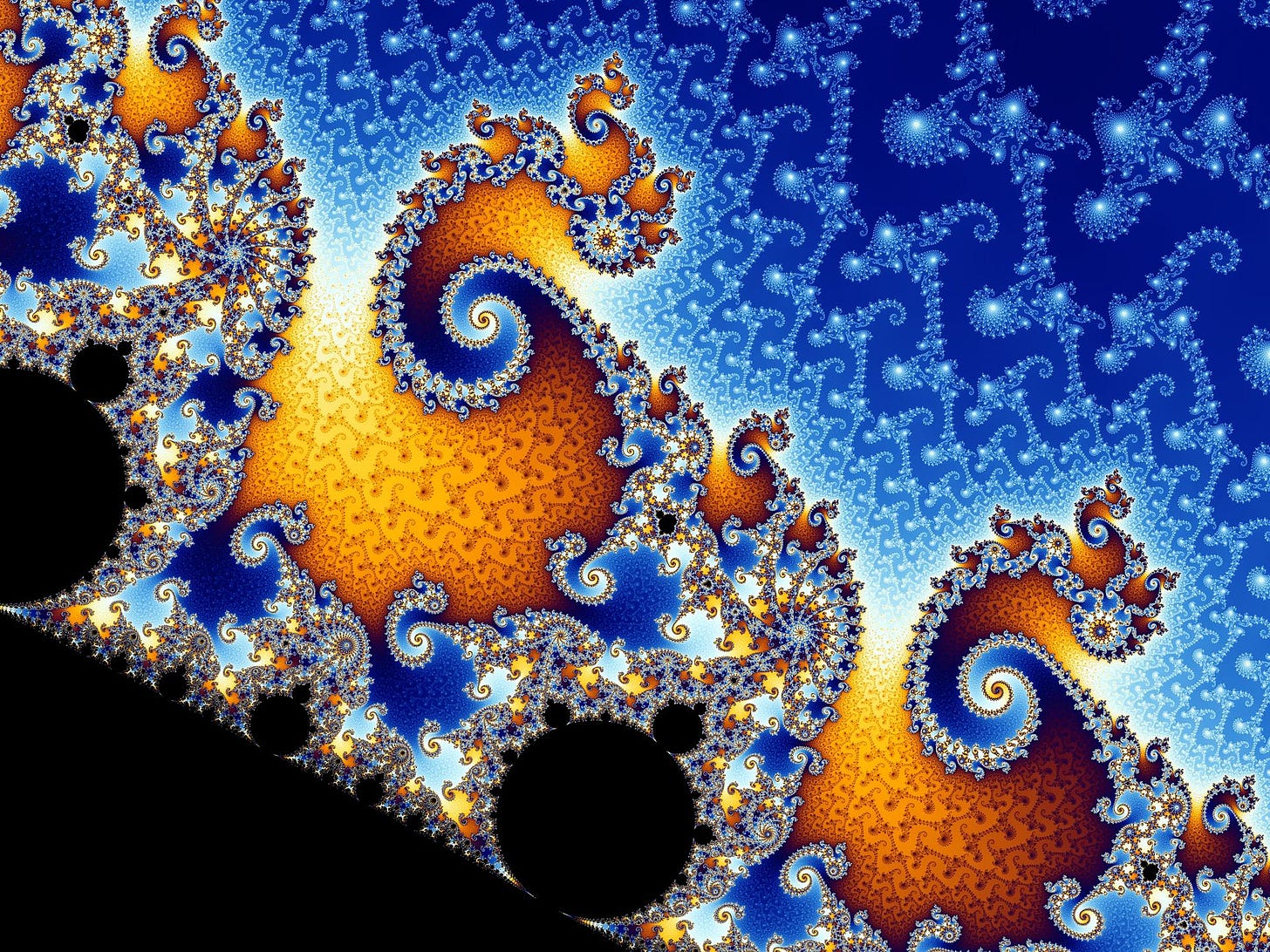☞ Multiplayer Mandelbrot
Mathematical Bestiaries and Multiplayer Fractal Spelunking
I recently got a copy of the book Fractal Creations, written by Timothy Wegner and Mark Peterson and published in 1991. I had vaguely remembered this book from my childhood, full of information on fractals and similar mathematical shapes. While some of the book’s contents are focused on Fractint, a piece of software for generating fractals, to be honest, I’m not sure I ever used the program (I don’t even know if it was compatible with our Macintosh). Instead, I recall enjoying the book’s collection of mathematical objects, from Gingerbreadman to Julia sets, that were described. There were formulas included, and other details necessary for generating all of this diversity yourself. This was a DIY mathematical bestiary.
But these particular beasts are special, for buried within them is an infinite level of complexity and beauty. Take the Mandelbrot set, the granddaddy of fractals. As you dive deeper and deeper into the set, you can find more and more strange images, such as this:
The above image, relative to the zoomed-out Mandelbrot set, has been magnified over 62 million times!
As the book Fractal Creations tries to explain, there is a vast scale one must contend with when it comes to zooming into the Mandelbrot set: “A Mandelbrot set blown up to the scale of the most extreme zoomed view you can see on your PC screen with Fractint would be one billion miles wide. That is ten times the distance from the earth to the sun; almost the distance to Jupiter.” (emphasis in original).
The book helpfully includes this figure:
As the authors conclude:
What are the chances, then, that in your fractal explorations you will find a piece of the Mandelbrot set never before seen with human eyes? Not only pretty good, but virtually certain, as a matter of fact.
And that is only a bit of what’s possible! Our computational powers have increased quite a bit since 1991.
This crazy deep zoom of the Mandelbrot set is magnified 2.1x10275 times. And as per this website about another zooming in of the Mandelbrot set:
So when you are exploring the Mandelbrot set (such as using this app), you are not just playing with mathematical objects. You are in a realm of discovery, seeing worlds that no one has ever seen before. You are almost guaranteed to be spelunking into virgin mathematical caves, exploring images never before seen. This is wild and humbling. It also seems then that these fractal bestiaries are more like atlases then, but for worlds of mathematics mingled with code.
I’ve been following Matt Webb’s experiments in incorporating multiplayer dynamics into the Web (eg. here and here), and I recently enjoyed Maggie Appleton’s essay about ambient co-presence.
So, the question must be asked: what would be an appropriate multiplayer experience be for exploring an infinitely deep mathematical object? Where is my Multiplayer Mandelbrot set and how would it work, when everyone is nearly guaranteed to be trekking along paths never before trodden? Would it mean leaving trails for future explorers? Favoriting certain regions that are particularly interesting? Multiplayer cursors that change size based on the magnitude of the zoom? Or only snap into focus when you are at the same level of zoom? As Matt Webb noted to me, the z-axis allows for lots of possibilities to play with.
Anyway, I want to know what a Multiplayer Mandelbrot could be! And if anyone is interested in building this, please reach out to me. ■
Question for Readers!
I believe that computational models in academic labs are often maintained by a single individual, a sort of keeper of their esoteric lore. What are some good examples of these? Please respond to me with anything relevant!
The Enchanted Systems Roundup
Here are some links worth checking out that touch on the complex systems of our world (both built and natural):
🝊 Diagram Website: A map of an intriguing subset of the Internet, including my Garden of Computational Delights.
🜸 Mapping Middle-earth: The lopsided demographics of Tolkien’s universe: “82% of Tolkien’s characters are male. Hobbits come closest to parity, with 30% women, followed by Men (which is what Tolkien called the human race in his books), where the imbalance is 87% versus 13%.”
🝳 Skateboarding, Drought, and Innovation: Wild: “persistent drought in southern California in the 1970s caused the emptying of pools, giving rise to de facto urban skateboard parks. This, in turn, helped drive the rise of skateboarding companies, skateboard media, and an entire subculture that eventually became mainstream.”
🜚 Cold-blooded software: “A cold-blooded project uses boring technology. The build and test scripts don’t depend on external services that might change, break, or disappear entirely.”
🝖 An AI Future Is Much Shakier Than You Think: “The ghosts of past futurism give pause to predictions of digital change.”
🜹 Everybody in History, Everywhere, all at Once: On the number of remembered people throughout history.
Until next time.





Multiplayer Mandelbrot made me immediately think of the Minecraft walk videos. I could see someone narrating their journey inside these fractals and others following along as an entire genre 😍 Maybe the setting for a Cabinet of Wonders podcast?
> Anyway, I want to know what a Multiplayer Mandelbrot could be!
Collaborative or competitive?
I did think there is a way to generate a path as the other person walks the path.
Love this incredible painting at the top.